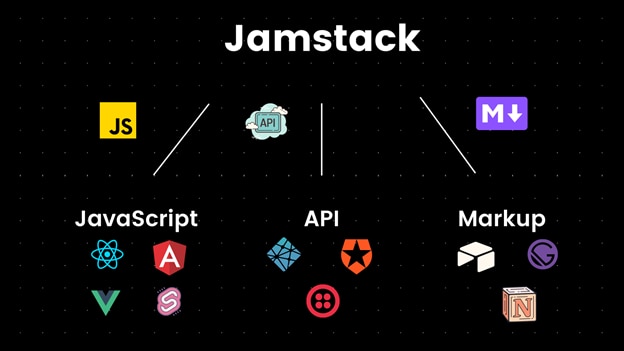JAM stack: The Modern Web Architecture Powering Speed & Scale
 Hariharan J
Hariharan JThe future of the web isn’t a stack of servers. It’s pre-rendered, decoupled, and API-driven.”

What is JAM stack?
JAM stack stands for JavaScript, APIs, and Markup a modern architecture that decouples the frontend from the backend, enabling faster, more secure, and scalable websites. But here’s the twist JAM stack isn’t a technology, it’s an architecture philosophy. Instead of relying on server-side rendering on every request, JAM stack pre-builds pages at deploy time and fetches dynamic content using APIs.
Architecture: Traditional vs JAM stack

JAM stack Components
JavaScript – Handles dynamic functionality. Runs entirely on the client-side.
APIs – Connects to microservices or serverless functions.
Markup – Pre-built HTML using static site generators like Next.js, Hugo, Astro, etc.
JAM stack in Action: A Simple Flow
// Fetching content from a headless CMS like Strapi
fetch('https://cdn.strapi.com/spaces/your_space_id/entries', {
headers: {
Authorization: `Bearer YOUR_ACCESS_TOKEN`
}
})
.then(res => res.json())
.then(data => renderContent(data));
Why JAM stack? (Pros)
Speed – Static files served from CDN are lightning-fast.
Security – No server = fewer attack surfaces.
Scalability – CDN handles load, not your origin server.
Developer Experience – Use modern tools, CI/CD, Git workflows.
Flexibility – Connect any service: Auth, Payments, CMS, etc.
The Catch? (Cons)
❌ Initial Build Time – Large sites may face long build times.
❌ Dynamic Complexity – Real-time features need careful API planning.
❌ SEO Considerations – Client-side rendered content can cause SEO issues if not pre-rendered.
Use-Cases Where JAM stack Shines
📰 Blogs & Documentation – Pre-rendered content = blazing speed.
🛍️ E-commerce Frontends – Use Stripe APIs, headless CMS.
📊 Dashboards & Portfolios – Personalized data via serverless functions.
🌐 Landing Pages – Fast, SEO-optimized, and cost-effective.
Real-World Stack Example
Let's say you're building a tech blog:
JavaScript: React (Next.js for pre-rendering)
APIs: Contentful (CMS), Netlify Functions (email form)
Markup: Markdown files pre-built at deploy via GitHub + CI
Tools That Power JAM stack
Frontend: Next.js, Astro, SvelteKit, Eleventy
CMS: Sanity, Contentful, Strapi, Ghost
Deployment: Netlify, Vercel, Cloudflare Pages
Auth & Forms: Auth0, Clerk, Formspree
Serverless: AWS Lambda, Vercel Functions, Supabase Edge Functions
Pro Tips from the Field
Use Incremental Static Regeneration (ISR) for frequently updated pages.
Use headless CMS to empower non-developers to edit content.
Embrace atomic deployments every deploy is a full site rebuild.
Final Thoughts
JAM stack isn’t just a “trend” it’s a mindset shift toward performance-first, decoupled development. With tools maturing and developer adoption growing, now is the perfect time to rethink your stack.
Build once, serve everywhere — that’s the JAM stack advantage.
Are you building with JAM stack or planning to migrate? I'd love to hear about your stack! Drop a comment or connect with me let’s shape the future of the web, one static site at a time.
Subscribe to my newsletter
Read articles from Hariharan J directly inside your inbox. Subscribe to the newsletter, and don't miss out.
Written by
Hariharan J
Hariharan J
👋 Hi, I’m Hariharan — a passionate Front-End Developer turning ideas into smooth, high-performing web apps. 💼 Web Dev @ Lumel | Skilled in React.js, Next.js, TypeScript & Strapi.js. 🚀 I love solving problems with clean code, crafting great user experiences, and exploring modern web tech like JAMstack. ✨ Also a content creator, sharing my dev journey & tips with the tech community. 🤝 Open to collabs, job opportunities, and mentorship! 📧 j.hariharan005@gmail.com | DM me to connect!